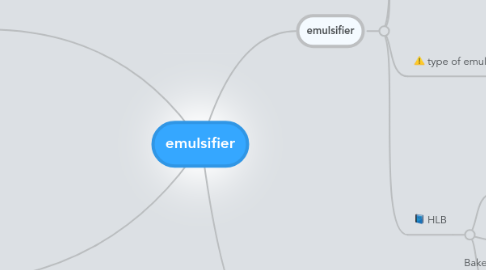
1. emulsion
1.1. -a dispersed two phase system whereby one phase is dispersed in the other in the form of fine droplets
1.2. stability depend to:- -degree of division of the inner phase -quality stability of the interfacial film -viscosity of the outer phase
2. some common emulsifier
2.1. mono + di- glycerides
2.2. sucrose esters
2.3. sorbitan esters
2.4. polisorbates
2.4.1. polysorbate 60
2.4.2. polysorbate 65
2.4.3. polysorbate 65
2.5. stearoyl lactylates
2.6. lecithin @ derivatives
3. emulsifier
3.1. substances that reduce surface tension at the interface of two normally immiscible phase,allowing them to mix and form an emulsion
3.2. f(x)
3.2.1. to promote emulsion stability, stabilize aerated system, control agglomeration of fat globules
3.2.2. to modify texture, shelf life and rheological properties by complexing them with starch and protien components
3.2.3. to improve texture of fat based food by controlling the polymorphism of fats
3.3. type of emulsifier
3.3.1. non ionic
3.3.1.1. uncharge molecule relatively
3.3.2. anionic
3.3.2.1. posses a negative electrical charge
3.3.3. cation
3.3.3.1. posses a positive electrical charge
3.3.4. amphoteric
3.3.4.1. posses both negative and positive electrical charge
3.4. HLB
3.4.1. expressed the balance of size and strength of the hydrophilic and the lipophilic group on the emulsifier
3.4.2. High HLB (>10 ) - more Hydrophilic HLB (1 -10) - more lipophilic
3.4.3. f(x)
3.4.3.1. describe the emulsifiying properties of non ionic emulsifier
3.4.3.1.1. HLB 3-6 = good emulsifier HLB 7- 9 = good wetting agent, can use for w/o or o/w emulsifier HLB 10-18 = good o/w emulsifier
4. application of emulsifier
4.1. Baked , rod , buns
4.1.1. dough conditioner / strengthening
4.1.2. crumbsofteners
